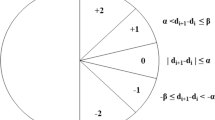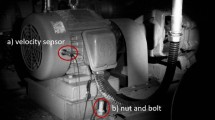Abstract
Machine health management is one of the main research contents of PHM technology, which aims to monitor the health states of machines online and evaluate degradation stages through real-time sensor data. In recent years, classic sparsity measures such as kurtosis, Lp/Lq norm, pq-mean, smoothness index, negative entropy, and Gini index have been widely used to characterize the impulsivity of repetitive transients. Since smoothness index and negative entropy were proposed, the sparse properties have not been fully analyzed. The first contribution of this paper is to analyze six properties of smoothness index and negative entropy. In addition, this paper conducts a thorough investigation on multivariate power average function and finds that existing classical sparsity measures can be respectively reformulated as the ratio of multivariate power mean functions (MPMFs). Finally, a general paradigm of index design is proposed for the expansion of sparsity measures family, and several newly designed dimensionless health indexes are given as examples. Two different run-to-failure bearing datasets were used to analyze and validate the capabilities and advantages of the newly designed health indexes. Experimental results prove that the newly designed health indexes show good performance in terms of monotonic degradation description, first fault occurrence time determination and degradation state assessment.
Similar content being viewed by others
References
Y. Lei, N. Li, L. Guo, N. Li, T. Yan and J. Lin, Machinery health prognostics: A systematic review from data acquisition to RUL prediction, Mechanical Systems and Signal Processing, 104 (2018) 799–834.
M. Ma and Z. Mao, Deep-convolution-based LSTM network for remaining useful life prediction, IEEE Transactions on Industrial Informatics, 17(3) (2021) 1658–1667.
J. Lee, F. Wu, W. Zhao, M. Ghaffari, L. Liao and D. Siegel, Prognostics and health management design for rotary machinery systems-reviews, methodology and applications, Mechanical Systems and Signal Processing, 42(1–2) (2014) 314–334.
X. Zhang, Y. Qin, C. Yuen, L. Jayasinghe and X. Liu, Time-series regeneration with convolutional recurrent generative adversarial network for remaining useful life estimation, IEEE Transactions on Industrial Informatics (2021).
J. Park, S. Kim, J. H. Choi and S. H. Lee, Frequency energy shift method for bearing fault prognosis using microphone sensor, Mechanical Systems and Signal Processing, 147 (2021) 107068, Available: https://doi.org/10.1016/j.ymssp.2020.107068.
H. Miao, B. Li, C. Sun and J. Liu, Joint learning of degradation assessment and RUL prediction for aeroengines via dual-task deep LSTM networks, IEEE Transactions on Industrial Informatics (2019).
P. Baraldi, G. Bonfanti and E. Zio, Differential evolution-based multi-objective optimization for the definition of a health indicator for fault diagnostics and prognostics, Mechanical Systems and Signal Processing, 102 (2018) 382–400.
Y. Miao, M. Zhao and J. Hua, Research on sparsity indexes for fault diagnosis of rotating machinery, Measurement: Journal of the International Measurement Confederation, 158 (2020) 107733.
B. Hou, D. Wang, T. Yan, Y. Wang, Z. Peng and K. L. Tsui, Gini indices II and III: two new sparsity measures and their applications to machine condition monitoring, IEEE/ASME Transactions on Mechatronics, 27 (3) (2021).
Y. Cao, Research on sparsity measures for rotating machinery health monitoring, arXiv:2205.00178 (2022).
R. F. Dwyer, Detection of non-gaussian signals by frequency domain kurtosis estimation, ICASSP, IEEE International Conference on Acoustics, Speech and Signal Processing — Proceedings (1983).
J. Antoni and R. B. Randall, The spectral kurtosis: application to the vibratory surveillance and diagnostics of rotating machines, Mechanical Systems and Signal Processing, 20(2) (2006) 308–331.
J. Antoni, The spectral kurtosis: a useful tool for characterising non-stationary signals, Mechanical Systems and Signal Processing, 20(2) (2006) 282–307.
Y. Wang, J. Xiang, R. Markert and M. Liang, Spectral kurtosis for fault detection, diagnosis and prognostics of rotating machines: A review with applications, Mechanical Systems and Signal Processing, 66–67 (2016) 679–698.
J. Zhong, D. Wang, J. Guo, D. Cabrera and C. Li, Theoretical investigations on kurtosis and entropy and their improvements for system health monitoring, IEEE Transactions on Instrumentation and Measurement (2021).
D. Wang, Some further thoughts about spectral kurtosis, spectral L2/L1 norm, spectral smoothness index and spectral Gini index for characterizing repetitive transients, Mechanical Systems and Signal Processing, 108 (2018) 360–368.
H. Dalton, The measurement of the inequality of incomes, The Economic Journal, 30(119) (1920) 348–361.
N. Hurley and S. Rickard, Comparing measures of sparsity, IEEE Transactions on Information Theory (2009).
Y. Miao, J. Wang, B. Zhang and H. Li, Practical framework of Gini index in the application of machinery fault feature extraction, Mechanical Systems and Signal Processing, 165 (2022) 108333.
B. Han, Z. Yang, Z. Zhang, H. Bao, J. Wang, Z. Liu and S. Li, A novel rolling bearing fault diagnosis method based on generalized nonlinear spectral sparsity, Measurement, 198 (2022) 111131.
X. Jia, M. Zhao, Y. Di, P. Li and J. Lee, Sparse filtering with the generalized lp/lq norm and its applications to the condition monitoring of rotating machinery, Mech. Syst. Signal Process, 102 (2018) 198–213.
Z. Zhang, S. Li, J. Wang, Y. Xin, Z. An and X. Jiang, Enhanced sparse filtering with strong noise adaptability and its application on rotating machinery fault diagnosis, Neurocomputting, 398 (2020) 31–44.
D. Wang, Spectral L2/L1 norm: a new perspective for spectral kurtosis for characterizing non-stationary signals, Mech. Syst. Signal Process, 104 (2018) 290–293, https://doi.org/10.1016/j.ymssp.2017.11.013.
J. Antoni, The infogram: entropic evidence of the signature of repetitive transients, Mechanical Systems and Signal Processing, 74 (2016) 73–94.
I. S. Bozchalooi and M. Liang, A smoothness index-guided approach to wavelet parameter selection in signal de-noising and fault detection, Journal of Sound and VibrationI, 308 (2007) 246–267.
Y. Miao, M. Zhao and J. Lin, Periodicity-impulsiveness spectrum based on singular value negentropy and its application for identification of optimal frequency band, IEEE Transactions on Industrial Electronics (2019).
R. Dykstra and B. C. Arnold, Majorization and the Lorenz order: A brief introduction, Journal of the American Statistical Association, 83(404) (1988) 1219.
B. Hou, D. Wang, T. Xia, Y. Wang, Y. Zhao and K. L. Tsui, Investigations on quasi-arithmetic means for machine condition monitoring, Mechanical Systems and Signal Processing, 151 (2021) 107451, Available: https://doi.org/10.1016/j.ymssp.2020.107451.
B. Hou, D. Wang, Y. Wang, T. Yan, Z. Peng and K. L. Tsui, Adaptive weighted signal preprocessing technique for machine health monitoring, IEEE Transactions on Instrumentation and Measurement, 70 (2021).
F. T. Liu, K. M. Ting and Z. H. Zhou, Isolation-based anomaly detection, ACM Transactions on Knowledge Discovery from DataI, 5 (2012) 1–44.
B. Wang, Y. Lei, N. Li and N. Li, A hybrid prognostics approach for estimating remaining useful life of rolling element bearings, IEEE Transactions on Reliability, 69(1) (2020) 401–412.
Acknowledgments
This work is supported by the National Natural Science Foundation of China (Grant No.52075095). Comments and suggestions from the editor and reviewers are very much appreciated.
Author information
Authors and Affiliations
Corresponding author
Additional information
Yudong Cao received the B.Eng. degree in mechatronic engineering from the School of Mechanical Engineering, Jiangnan University, Wuxi, China, in 2019, and the M.Eng. degree in mechanical engineering from Southeast University, Nanjing, China, in 2022. He is currently working toward the Ph.D. degree. His research interests include machine status monitoring and fault diagnosis, prognostic and health management for rotating machinery, intelligence systems, and machine learning.
Minping Jia received the B.S. and M.S. degrees from the Nanjing Institute of Technology (now Southeast University), Nanjing, China, in 1982 and 1985, respectively, and the Ph.D. degree from Southeast University, Nanjing, China, in 1991, all in mechanical engineering. He is currently a Full Professor with Southeast University, Nanjing, China. His research interests include dynamic signal processing, machine fault diagnosis, and vibration engineering applications.
Jichao Zhuang received the B.S. degree from Guangdong Ocean University, Zhanjiang, China, in 2018, and the M.S. degree from Yanshan University, Qinhuangdao, China, in 2020. He is currently pursuing the Ph.D. degree with the School of Mechanical Engineering, Southeast University, Nanjing, China. His research interests include machine fault diagnosis and dynamic signal processing.
Xiaoli Zhao received his M.S. degree from LanZhou University of Technology, Lanzhou, China, in 2017. He received the Ph.D. degree in Mechanical engineering from School of Mechanical Engineering, Southeast University, Nanjing, P. R. China, in 2021. From September 2019 to September 2020, he was also as a visiting Ph.D. scholar in the School of Engineering, the University of British Columbia, Okanagan, Canada. Now, he is currently an Assistant Professor in School of Mechanical Engineering, Nanjing University of Science and Technology, Nanjing, P. R. China. His main research interest is intelligent monitoring and fault diagnosis, Prognostic and Health Management for electromechanical and hydraulic system, artificial intelligence and signal processing, robot technology.
Rights and permissions
About this article
Cite this article
Cao, Y., Jia, M., Zhuang, J. et al. Research on sparsity measures for rotating machinery health monitoring. J Mech Sci Technol 36, 5831–5843 (2022). https://doi.org/10.1007/s12206-022-1102-x
Received:
Revised:
Accepted:
Published:
Issue Date:
DOI: https://doi.org/10.1007/s12206-022-1102-x




